Brindle French Bulldog: Color Varieties, Price, Care

If you’ve ever seen a French Bulldog with what looks like subtle tiger stripes, you’ve spotted a brindle French Bulldog. Brindle is a coat pattern (not a specific color) characterized by streaks of darker pigment on a lighter background, often described as “tiger-striped” but more subtle.
In Frenchies, this striking pattern gives each dog a one-of-a-kind look – no two brindle coats are exactly alike.
What Makes Brindle French Bulldogs Unique?
Brindle French Bulldogs stand out thanks to their unique coat pattern. Unlike a solid-colored Frenchie, a brindle Frenchie has a base coat with darker stripes or flecks overlaying it. Typically, you’ll see black stripes on a fawn (reddish-tan) base coat, giving that classic brindled look.
The pattern can range from sparse striping to heavy, almost solid coloration. This coat pattern has long been part of the French Bulldog breed’s history and charm. In fact, brindle (along with fawn) is one of the most common Frenchie coat colors.
What makes brindle particularly interesting is how dynamic it is. The exact shade and intensity of the pattern can vary widely. Some brindle Frenchies have very pronounced, high-contrast stripes, while others have a softer, blended look. The pattern is also affected by other color genes. For instance, if a Frenchie has the dilution gene, those “black” stripes may actually appear gray or bluish.
Another unique aspect is that brindle is a dominant coat pattern genetically. This means if a French Bulldog inherits the brindle gene from just one parent, it will usually display the brindle pattern. Many Frenchie enthusiasts love that the brindle pattern is so distinctive yet common in the breed – it’s a standard, accepted pattern in show rings, but each brindle dog’s markings are uniquely its own.
Color Variations of Brindle French Bulldogs
One of the exciting things for Frenchie lovers is that brindle comes in many shades and combinations. The base coat and stripe colors can vary, leading to several named variations that enthusiasts often talk about. Below we explain each of the main color variations of brindle French Bulldogs and what makes them special:
Blue Brindle French Bulldog
A blue brindle French Bulldog has the classic brindle pattern, but with a genetic twist: the dog carries the dilution gene that turns black pigment into a grayish-blue. In a blue brindle, the dark stripes that would normally be black are instead a steel gray or bluish color.
The base coat (the lighter background) is usually a shade of fawn but may also be a cooler, ash-toned tan due to the dilution. This gives the dog an overall gray brindle appearance, which some people also refer to as the grey brindle French Bulldog (using “grey” interchangeably with blue).
Blue brindle Frenchies are striking to look at. Their coat can appear slate-gray with subtle striping. Because the blue/gray color is the result of a recessive gene, blue brindle puppies are less common than standard black brindles, and they often fall into the rare French Bulldog colors category.
Keep in mind that while blue brindle is beautiful, the dilution gene responsible for the blue tint can sometimes be linked to coat health issues like color dilution alopecia. It’s a condition rhat causes patchy hair loss in some blue-coated dogs.
Not all blue brindles will have this issue, but it’s something to be aware of when admiring or owning a blue brindle Frenchie. Overall, a blue brindle combines the flashy pattern of brindle with the eye-catching slate blue hue.
Black Brindle French Bulldog
The black brindle French Bulldog is what most people think of as the “classic” brindle. These dogs have a fawn or light brown base coat overlaid with deep black striping. In many black brindle Frenchies, the black stripes can be thick and numerous, sometimes making the dog look almost black from a distance except for the streaks of lighter hair peeking through.
This is one of the most common coat patterns in French Bulldogs. In fact, brindle (black brindle) is reported as the most common color in the breed.
A black brindle Frenchie might have a coat that looks dark chocolate or seal-colored in low light, but up close you’ll notice the lighter fawn hairs mixed in. Often, they’ll also have some white patches on the chest or toes (which is normal in Frenchies). What’s great about black brindle is that it’s a standard French Bulldog color per kennel club breed standards.
This means if you’re into showing dogs, a black brindle Frenchie is fully accepted in the show ring. Even if you’re not showing, black brindle is beloved for its classic, bull-doggy appearance – many of the early French Bulldogs were brindle, so it’s a bit of a breed hallmark.
Fawn Brindle French Bulldog
A fawn brindle French Bulldog generally refers to a brindle coat where the fawn (tan) base color is more dominant and the striping may be lighter or less pronounced. Essentially, think of a fawn Frenchie (which is a solid light tan or caramel color) that got a light brush of black striping on top.
In some fawn brindles, the stripes might be sparse or thin, allowing the warm fawn color to really shine through. This is sometimes just called “brindle” as well, since any Frenchie with stripes is brindle, but enthusiasts might use fawn brindle to describe a dog whose overall look is lighter or more tan-colored than a typical dark brindle.
These Frenchies often have a very balanced appearance – at a glance they might even appear medium brown, and only on closer inspection do you see the brindle pattern. Fawn brindle is not a separate genetic color, just a descriptive way to say the brindle pattern is on a lighter base coat.
Some people love this variation because the striping is subtle, giving a beautiful marbled effect. Like black brindle, fawn brindle is also within the standard color range for French Bulldogs (since it’s just a lighter version of brindle), so it’s commonly seen and accepted.
 Reverse Brindle French Bulldog
Reverse Brindle French Bulldog
Reverse brindle French Bulldog refers to a pattern effect rather than a truly separate color. In a reverse brindle, the usual light/dark distribution is “flipped” in appearance – the dark color is more predominant and the lighter color appears in the striping. In other words, where a normal brindle is fawn with black stripes, a reverse brindle might look black or very dark brown with fawn stripes.
The term can be a bit confusing, because genetically the dog is still a brindle. It’s just that the brindling is so heavy or dense that the lighter base barely shows through.
This results in a dog that might look black or seal at first glance, until you notice the lighter streaks (which are the inverse of a typical brindle’s dark streaks).
Reverse brindle Frenchies often have a dramatic look – they can appear to be a very dark brindle. Some French Bulldog owners actually seek out puppies with this pattern because they prefer the darker coat.
Keep in mind, if a Frenchie is so dark that it has no visible striping or only a tiny bit of lighter hair, then it might be considered a fault in show terms (a solid black without brindle is not an accepted show color in Frenchies).
But as long as those stripes exist, it’s a brindle. Reverse brindle is basically just an extreme form of black brindling. It doesn’t affect the dog’s health or personality, but it’s a cool coat pattern variation to be aware of.
Lilac Brindle French Bulldog
The Lilac is one of those ultra-rare and exotic Frenchie colors, and yes, you can have a lilac brindle French Bulldog too. “Lilac” in Frenchies usually means the dog has two copies of the blue dilution gene and two copies of the chocolate gene, resulting in a coat that is a pale silvery-brown color (often with a slight purple hue, hence lilac).
So, a lilac brindle would have that rare base color combined with the brindle striping pattern. The stripes in a lilac brindle are usually a lighter brownish-purple (because the black pigment is diluted twice by both the blue and chocolate factors), and the base might be a soft beige or champagne color.
They are extremely rare
Lilac brindle Frenchies are extremely rare. They are typically only produced by breeders who specialize in exotic color French Bulldogs. Because the lilac color requires multiple recessive genes, adding brindle on top of that narrows the odds further – one of the parents must also provide the dominant brindle gene. The result, however, can be stunning: a faintly purple-tinted coat with subtle brindle striping.
These puppies often come with a very high price tag and are considered exotic in the world of Frenchies. It’s important to note that since lilac (and other rare colors) aren’t recognized by most breed clubs, a lilac brindle Frenchie won’t be eligible for conformation show. However, that doesn’t make them any less of an amazing companion. Just like blue brindles, lilac brindles might have some coat sensitivity (color-dilution related) and you’ll want to ensure any breeder is prioritizing health along with color.
Grey Brindle French Bulldog
The term grey brindle French Bulldog is often used interchangeably with blue brindle. “Grey” is basically describing the same dilute black pigment that we call blue in dog coat color genetics. However, some people might say grey brindle to refer to a brindle with a very soft or pale gray appearance. It’s essentially another name for a blue brindle Frenchie.
In a grey brindle, you’ll see the dog has a grayish overall tone – the dark stripes are gray instead of jet black, and the fawn base may also be a cooler, ashy tan.
This can happen if a brindle Frenchie has the blue gene (dilution) affecting its coat. Sometimes Frenchies that are a mix of blue and fawn in their lineage produce brindles that are not as dark or high-contrast; these could be casually described as grey brindles as well.
So, to avoid confusion: usually grey = blue in French Bulldog color lingo. A grey brindle French Bulldog will look very much like the blue brindle we described earlier.
If you hear someone advertising a “grey brindle Frenchie,” it’s likely the same thing as a blue brindle. Always check the photos to see the coat – you should notice that telltale bluish cast to the dark areas. No matter what you call it, a grey/blue brindle is a beautiful variation that combines the rare grey coat with the beloved brindle pattern.
The Genetics Behind Brindle Coloring in French Bulldogs
The brindle pattern in French Bulldogs is caused by a gene that affects coat color distribution. Without getting too technical, there is a location on the dog’s DNA called the K-locus that controls brindling.
The brindle pattern is usually designated by the allele K<sup>br</sup>. If a Frenchie has one copy of K<sup>br</sup>, it can show brindle (provided it also has the genes for a fawn base color to put stripes onto). This makes brindle a dominant trait – a puppy can get the brindle gene from just one parent and end up with a brindle coat.
In French Bulldogs, brindle commonly appears as those black stripes on a reddish-tan base. The dark stripes are made of the pigment eumelanin (which is usually black or brown), and the lighter background is made of phaeomelanin (red or yellow pigment).
Different genes can modify these pigments. For example, the dilution gene (affecting eumelanin) can turn black into blue/gray – which is why a blue brindle has gray stripes instead of black. Likewise, a chocolate gene could turn those stripes brown.
The base color (phaeomelanin) can be intensified or lightened by other genes, which is why some brindle Frenchies have a rich red base and others a pale cream base.
Essentially, brindle is like a pattern template, and the dog’s other color genes determine the palette (black/blue/chocolate stripes, fawn/cream base, etc.).
Recessive gene carriers
Interestingly, genetically testing for brindle isn’t straightforward. Brindle is known to be caused by a form of mosaicism in some cases, meaning it’s a bit complex – dogs that carry brindle usually test as having one dominant and one recessive gene at that K-locus (often written as K<sup>B</sup>k<sup>y</sup>, where K<sup>B</sup> is a solid black gene).
In fact, a dog can carry brindle and not show it if it also has the dominant black gene (which would cover up the stripes). However, in Frenchies, the dominant black (solid black coat) is generally not part of the standard lines, so most Frenchies either have brindle or not, without that hidden scenario.
What’s important to know is that to get a brindle French Bulldog puppy, at least one parent must carry brindle (and usually that parent will be brindle, since it shows up visibly). Two non-brindle parents typically won’t produce a brindle pup.
The brindle pattern is inherited and pretty simple—if a Frenchie carries the gene, those stripes will show. The variations in color (blue brindle, lilac brindle, etc.) come from layering other color genes on top of brindle.
This is why breeders who aim for rare colors have to consider a combination of genetics – for example, to produce a lilac brindle, they need to give the puppy genes for both blue and chocolate (for the lilac) plus the brindle gene for the pattern.
Brindle vs. Standard and Rare French Bulldog Colors
How does brindle compare to other colors in the French Bulldog world? Frenchies come in a wide array of coat colors, but they are generally categorized into standard colors (recognized by major kennel clubs and breed standards) and rare/exotic colors (not recognized by clubs, often newer or produced through specific breeding for the pet market). Brindle falls into the first category.
Standard colors
Standard French Bulldog colors include brindle (and brindle & white), fawn (ranging from light tan to red fawn), cream, and pied versions of these (pied means large patches of white with one of the standard colors).
The American Kennel Club (AKC) and other clubs explicitly list these as acceptable. Among these, brindle and fawn are the most common in Frenchies. If you attend a dog show or look at French Bulldog club literature, you’ll see that breed clubs do not recognize any other colors or patterns outside of that list. This means colors like blue, lilac, chocolate, merle, black-and-tan, etc., are considered non-standard.
Rare colors
Rare French Bulldog colors refer to those non-standard hues and patterns that some breeders specialize in for pet homes. Examples of rare/exotic colors are: blue (gray), chocolate (liver), lilac (blue+chocolate combo), merle (a different pattern of patches, coming from a separate gene), black and tan, blue fawn, and others.
You can definitely find these colors—and they’ve become pretty popular among Frenchie fans who love unique looks—but keep in mind they usually can’t compete in conformation shows and often come with a higher price tag. Still, “not recognized” doesn’t mean your dog isn’t a purebred Frenchie—it just means those colors weren’t historically part of the breed standard.
In some cases, rare colors made their way into the breed through outside genetics. For instance, the merle pattern likely came from another breed introduced somewhere along the line.
Where does the brindle French bulldog fit in? Brindle is actually a foundation color pattern for French Bulldogs. It’s not only standard but very traditional. Many of the earliest French Bulldogs were either solid brindle or brindle pieds. So brindle isn’t rare at all. In fact, if you’re looking for a Frenchie, a brindle French Bulldog puppy is often easier to find than one of the rare color pups.
Health and Care Considerations for Brindle Frenchies
When it comes to health and care, brindle French Bulldogs are generally the same as any other Frenchie. The brindle pattern itself doesn’t inherently cause health issues – it’s simply a coat color pattern.
Studies have shown French Bulldogs have significantly higher risk for conditions like brachycephalic airway syndrome (breathing difficulties) and skin fold dermatitis (irritation in their wrinkles) compared to other dogs.
They also commonly experience things like ear infections and allergies.
Skin and Coat Care
Brindle Frenchies have short, fine coats that are relatively low maintenance. A weekly brushing with a soft brush or grooming mitt can help remove loose hair and keep their coat shiny. They do shed, and you might notice lighter hairs (from the base color) and darker hairs (from the stripes) on your furniture or clothes. The shedding is moderate since they’re a short-haired breed.
If your Frenchie is a blue brindle or lilac brindle (with those dilution genes), pay attention to their skin condition. Color-diluted coats sometimes come with color dilution alopecia, which can cause thinning hair or dry skin patches on the blue areas.
Cleaning and Hygiene
Those adorable Frenchie wrinkles need care, brindle or not. Especially if your brindle buddy has any white markings (white areas can be prone to tear stains or yeast if not kept clean). Wipe their facial folds with a damp cloth or vet-recommended wipe regularly to prevent irritation. Also, check their ears often – Frenchies’ bat ears can trap dirt and they are prone to ear infections.
Exercise and Lifestyle
Brindle French Bulldogs have the same playful, sometimes stubborn, and affectionate temperament as others. They need moderate exercise – daily walks and some play time. Just be mindful of overheating. A dark brindle coat (especially a heavy reverse brindle that appears mostly black) might absorb more heat in the sun. Therefore, be extra cautious on hot days. Because they are stocky, watch out for back issues – discourage jumping off high furniture, as Frenchies can have spinal problems.
Tips for Buying a Brindle French Bulldog
When you’re searching for a brindle French Bulldog for sale, it’s important to go about it thoughtfully to make sure you’re bringing home a healthy, happy pup from a trustworthy breeder. Here are a few tips to help you along the way:
Find Reputable Breeders
Start by searching for French Bulldog breeders with good reputations. Ideally, choose breeders who register with kennel clubs or French Bulldog breed clubs. A reputable breeder will prioritize health and temperament over just color.
They should be knowledgeable about Frenchie health issues and open to your questions. If a breeder advertises nothing but “rare colors” and seems to be selling Frenchies like commodities, be cautious. It’s not that you can’t find a good breeder who breeds brindle (most do) or even exotic brindles. It’s that the breeder’s ethic matters.
Observe the Living Conditions
When you contact a breeder, ask to visit or at least do a video call to see the puppies and their environment. The puppies should appear clean, well-fed, and lively. The mother dog should be on site (in most cases) and you can gauge her health and temperament too.
Ask About Health and Genetics
Specifically for brindle, ask if the puppy’s parents are standard color or carry any special genes. For instance, if you’re buying a blue brindle, confirm that the breeder is aware of color dilution alopecia. Also, check whether parents have any skin issues. Good breeders will usually have a vet examine the puppies and might provide a health certificate. They may also offer a health guarantee for a certain period after purchase.
Expected Price Range
Brindle French Bulldog prices can vary widely based on location, breeder reputation, and whether the pup is standard color or carries rare color genes. Generally, a standard-color brindle Frenchie from a reputable breeder might cost anywhere from $2,000 to $4,000 USD (this can fluctuate with demand).
If the brindle is also a rare color (like blue or lilac brindle), the price could be higher – sometimes $5,000+ for those exotic traits. Always be wary of deals that seem “too cheap,” like a brindle Frenchie puppy for a few hundred dollars – scammers often lure people with low prices. Conversely, an extremely high price doesn’t always guarantee quality; it could just be a breeder capitalizing on a trend. Know the typical range so you can identify what’s reasonable.
Verify Documentation
When you do decide on a puppy, ensure you receive proper paperwork. This typically includes proof of vaccinations and deworming, possibly a microchip documentation if the breeder implanted one. Besides, any registration papers if applicable (for example, AKC registration if the breeder registered the litter).
Even if you only want a pet and not planning to show, having registration can be an indicator that the breeder isn’t hiding anything.
Breeders often sell perfectly healthy pet Frenchies on spay/neuter contracts without papers to ensure buyers don’t breed them. The key is transparency from the seller.
Buying a Brindle French Bulldog: Wrapping
Raising a brindle French Bulldog puppy is a delightful adventure. Brindle Frenchies combine the best of both worlds.
Whether you admire the flashy stripes of a reverse brindle, keep in mind that each Frenchie has their own unique personality. Focus on finding a healthy, well-bred pup or adult. Your Frenchie will reward you with endless love.

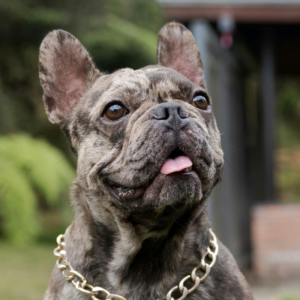
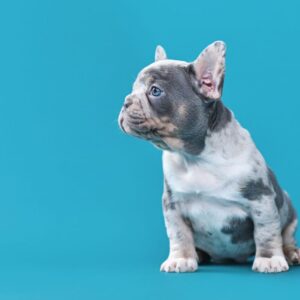
 Reverse Brindle French Bulldog
Reverse Brindle French Bulldog
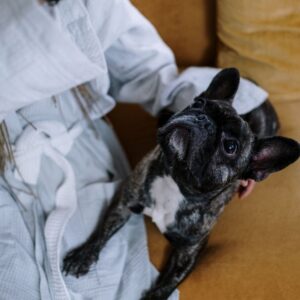
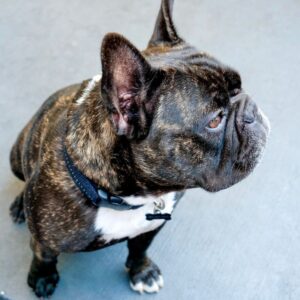
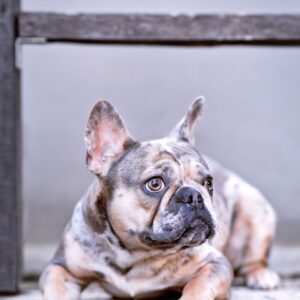

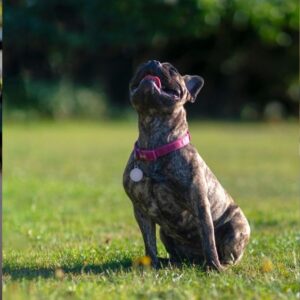


 French Bulldog Jackets & Coats
French Bulldog Jackets & Coats French Bulldog Dresses & Skirts
French Bulldog Dresses & Skirts French Bulldog Hoodies
French Bulldog Hoodies French Bulldog Sweaters
French Bulldog Sweaters French Bulldog Shirts
French Bulldog Shirts French Bulldog Pajamas
French Bulldog Pajamas French Bulldog Costumes
French Bulldog Costumes French Bulldog Life Jackets
French Bulldog Life Jackets

 French Bulldog Collars
French Bulldog Collars French Bulldog Harness
French Bulldog Harness
 French Bulldog Backpacks
French Bulldog Backpacks








One thought on “Brindle French Bulldog: Color Varieties, Price, Care”